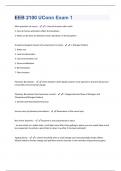Examen
EEB 2100 UConn Exam 1 Questions + Answers Graded A+
- Établissement
-
EEB 2100 UConn
Main questions of course - 1. How do humans alter earth
2. how do human alterations affect the biosphere
3. What can be done to alleviate human alterations of the biosphere
Greatest ecological impacts of humans(most to least) - 1. Nitrogen fixation
2. Water use
3. Land transformation
4. CO2 c...
[Montrer plus]
-
6 juillet 2024
-
16
-
2023/2024
-
Examen
-
Questions et réponses
-
EEB 2100 UConn
-
EEB 2100 UConn
S'abonner
EEB 2100 UConn Exam 1 Main questions of course - 1. How do humans alter earth 2. how do human alterations affect the biosphere 3. What can be done to alleviate human alterations of the biosphere Greatest ecological impacts of humans(most to least) - 1. Nitrogen fixation 2. Water use 3. Land transformation 4. CO2 concentration rise 5. Ocean acidification 6. Bird extinction 7. Plant invasion Planetary Boundaries - Limits between which global systems must operate to prevent abrupt and irreversible environmental change Planetary Boundaries that have been crossed - 1. Biogeochemical flows of Nitrogen and Phosphorous(Nitrogen fixation) 2. Genetic diversity (biodiversity loss) Success story of planetary boundaries - Restoration of the ozone layer Non -linear dynamics - Outcome is not proportional to input - to revert back to a stable state, it will take more effort than getting to where you are now(It takes much less equipment to pollute a pond than to clean it up after it has been polluted) Tipping Points - a critical threshold when a small change can have potentially drastic effects. Mostly linked to climate change and pollution and the increase in the emmition of greenhouse gases Increased atmospheric CO2 - Result of increased burning of fossil fuels and land use change(getting rid of plants by burning which uptake CO2) -caused global warming of 0.8 -1.2 degrees Celsius Oceanic CO2 - -25% of carbon from CO2 gets taken up by oceans -Caused the average ocean ph to drop by 0.1 units and because ph is a log scale resulted in 26% increased acidity causing major changes to ocean ecology nitrogen fixation - process of converting nitrogen gas into nitrogen compounds that plants can absorb and use Nitrogen in Ecosystems*dont understand* - added to ecosystems through fixation by microorganisms and limits the growth of many ecosystems Large mammal biomass - 97% of large mammal biomass is human(30%) or domestic animals(67%) Human water use - -35% of all of the earths usable water goes toward agricultural needs while 15% goes to other human needs -37% of rivers globally including 2% in the US are UNimpeded by dams which makes it hard for microorganisms and fish to travel Extinction rate on earth - -100-1000 times the background rate -Yearly loss of 11 -58k species -Rates only comparable to 5 times in last 500 million years which could indicate 6th mass extinction biotic homogenization - Certain species coexist well with humans so they are favored in many areas throughout the world, decreasing overall biodiversity in the world Examples of biotic homogenization - -mixing of biota(plant or animal life native to a certain region) across oceans -many continental regions have 20% of plant life as exotic(not native to the area) Big picture behind planetary boundaries - All these disturbances are connected to one another so one major change could result in an even large change somewhere else due to the many indirect consequences Anthropocene - a new geological period dominated by human destabilization of the earth's natural systems Common Geological time units - Eras: Hundreds of millions of years periods: 50 -200 million years epoch: 5 -30 million years Formal criteria for new geological time units - 1. Must be stratigraphic evidence(evidence in rock layers) for start date all over the world. 2. Must persist for millions of years 3. accompanied by a mass extinction "Golden Spike" - (GSSP) Global Stratotype Section and point and refers to evidence in geological strata that signifies the start of a new geological stage of time. Example of golden spike and geological time shift - Boundary between the cretaceous and paleogene periods that occured 66 million years ago with a meteor impact - layer of iridium rock not common to earth found in strata all over the world - global extinction of dinosaurs occurred How many mass extinctions have there been? - five(not including the one currently going on) When should the Anthropocene begin?(Scientist arguements) - 1.mega faunal extinctions 50 -10k years ago which was was defined by humans growing in numbers and over -hunting mega faunal animals 2. Dawn of agriculture 11 -8k years ago when hunting stopped and we stayed in one place to farm




